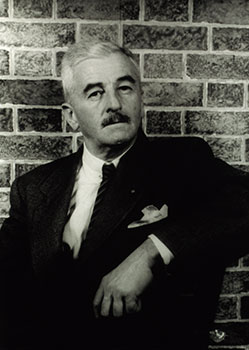Learn

William Faulkner
Born on September 25, 1897, in Mississippi, William Faulkner is often considered the most innovative American author of his time.

Faulkner began writing poetry as a teenager, and he published his first book of poetry, The Marble Faun, in 1924. However, he did not receive much success from this book. In 1925, Faulkner went to New Orleans and met Sherwood Anderson, whose friendship inspired Faulkner to start writing novels. In 1926, Faulkner's first novel, A Soldier's Pay was published; it sold few copies but was critically accepted.
Between the years 1926 and 1931, Faulkner wrote four more novels: Mosquitoes, Sartoris, The Sound and the Fury, and As I Lay Dying. None of these novels sold well at the time, and Faulkner earned very little money. It wasn't until the publication of Sanctuary in 1931 that Faulkner became financially successful. He won the Nobel Prize for Literature as well as two Pulitzer Prizes for A Fable and The Reivers.

"A Rose for Emily"
Take note before you read that the short story is told in medias res in the middle of a narrative , so the story presents the events out of order.
Read William Faulkner's "A Rose for Emily".

Literary Devices
Faulkner employs the use of flashback in his short story "A Rose for Emily." A flashback in a literary work interrupts the chronological presentation of events in order to relate an event from an earlier time. In the first line of the story, the reader learns that "Miss Emily Grierson died."
The setting of the story spans over the course of more than forty years from 1875 to 1920 in Jefferson, Mississippi.
The readers find out what is taking place in Miss Emily's life according to rumors and reports that the town creates. The conflict at the start of the story is the town's desire to collect tax money from Miss Emily, but Miss Emily refuses to pay it. Like the rest of the country, the South was changing, yet the character Miss Emily could not accept the changes taking place.
Faulkner presents Miss Emily as a dynamic character who is simplistic and could be from every day walks of life. He incorporates figurative language such as personification to paint pictures in the readers' minds.
Miss Emily's house is described as "lifting its stubborn and coquettish decay" and as having a "heavily light-some" architectural style; it was once a "select" street, but the neighborhood is no longer good. It is also the last house on a street that is now mostly a business district. The condition of Miss Emily's home shows that she is determined to live in the past.
Why do the townspeople believe Miss Emily and Homer got married?
What do you believe Miss Emily has planned for the poison?
What do the townspeople find in Miss Emily’s house after she has died?

News Writing
In the Task, you are going to write a news story about the events that occurred in "A Rose for Emily." Read the information below to find out how you will organize your article.
A news story is written by a reporter who interviews people and observes events to answer the questions:
- who,
- what,
- when,
- where,
- why, and
- how.
Usually newspaper articles are organized from the most important information to the least. This is called the inverted pyramid format.
A lead is the introductory sentence in the news article. This sentence leads with the most important aspect of the news story. Summary leads are where writers identify the 5Ws and 1H in the first two paragraphs. The remaining paragraphs of the article are short, providing details and explanations.
When writing a news article, think about what is the most important part of the story and begin with it. That is called the lead. Ask yourself what your readers need to know most. Starting with the most important piece, write a one or two sentence summary that relays the vital information of the article to readers.
Writers often use hooks to create reader interest. Some of the most common hooks are
- using a direct quote;
- posing a question;
- including an anecdote;
- comparing a large and small setting, idea, or way of life;
- incorporating dialogue;
- writing in the second person;
- comparing then to now, yesterday to today, of the way things were to the way they are now.

